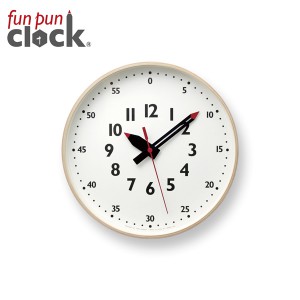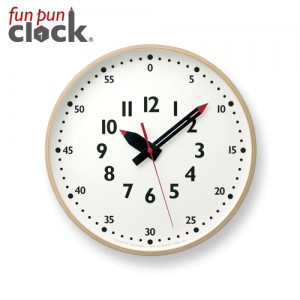φ3 6 5×d 4 8 m m / 9 7 0 g
 ●Mサイズ 8 , 0 0 0 円+税
●Mサイズ 8 , 0 0 0 円+税
φ3 0 5×d 4 8 m m / 7 2 5 g
ふんぷんクロック
時計の読めない子が、読みたいと思うアナログ時計。
2014年10月〜タカタレムノスから発売中です。
*上の画像をクリックすると、タカタレムノスのオンラインショップにてご購入頂けます。
ちょっぴりユーモラスな名前の由来は、“時”を表わす「1~ 12」の文字が、6 0 進法の“分”の読み方となった際に、「5ふん(f u n)」「10ぷん( p u n)」「15ふん(f u n)」「2 0ぷん( p u n)」~と交互に繰り返されることから名付けました。大人が子供に声がけしやすい、シンプルで素材の美しい、どのようなインテリアにも合う時計ができました。
[ 大きな3つの特徴をもった時計 ]
① 子供のいる風景に「笑顔」を増やす時計
子供が、どんなかたちであれ時計に積極的に関わりたがるタイミングがきたら、次のステップとして一緒に時計と関わろうとする大人の存在が重要になります。教育の現場だけでなく、日々の大半を過ごすご家庭で大人が意識して、行動と時間を結びつけてあげる事で子供は「どれくらいの時間で、自分はどんなことができるのか」を体で覚えるようになります。
お子様が時計に興味をお持ちになった際は、是非一緒に「音読」してあげてください。親子で、声をひそめて秒針の「コチコチ」という音を聞いたり、一緒に6 0まで数えたり、毎日お風呂やベッドに入る際に時刻を確かめたり、手で確認しながら「5フン・10プン」と声にだしたり。かけがえのない親子のコミュニケーションの柔らかな時間は、その最中には大変で気がつきませんが、人生のほんの一瞬しかない貴重なものです。
② 入り口のアナログ時計
「自分のことを自分でやりたい!」と願うお子さんが、時間の概念も身につけてくれたら、パパもママも助かりますよね。たとえば、「前よりも出かける準備を早くできるようになった」という“小さな実感”の積み重ねはお子様の自信に繋がります。タイミングを見て、時間と行動をセットにして成長を褒めてあげてください。子供も自分で計画をたてられることで自信をつけ、より大きな満足感を得られる経験の繰り返しで自信を深めます。また、アナログ時計は円グラフに通じる、感覚的に行動計画と一致させる事が出来るということから、デジタル主流の昨今でも見直されています。
③ 母親の視点と、モンテッソーリ教育理論を土台としたデザイン
子育て経験のある女性デザイナーの「母親の視点」と、日本モンテッソーリ教育綜合研究所の主任研究員・櫻井美砂様のご協力よる、専門家の意見を取り入れた上での商品開発を進めてきました。
「子どもは大人が思っている以上に知的好奇心が旺盛です。『これは何?』『どうして?』と熱心に質問を繰り返す姿は、自分の力でこの世界について知ろうと学ぶ、自己教育力(自分を育てる力)のあらわれといえます。少し工夫して、子どもが自分で分かるような環境を整えてあげれば、子どもは自ら環境に関わり、知性を生き生きと働かせ主体的に行動するようになります。大人の役割は知識を教え込むことではなく、子どもが自分で学んだり、考えたりすることのできる環境を整えることにあります。」 日本モンテッソーリ教育綜合研究所 主任研究員 櫻井美砂
意外に思われるかもしれませんが、数への興味は実は幼児の頃から芽生えています。その「数への興味」の一環で、時計に興味を持つ事も多いのです。その時期の幼児が、1~12の数字だけで、時針と分針が示す時刻を理解するのは難しく、補助的に分針が示す時刻を5 分、10 分・・・と母親が市販の時計に付け足す必要がありました。「f u n p u n c l o c k」には、モンテッソーリ教育の視点からヒントを得て「時間や時刻の理解を促す」為の仕掛けをちりばめています。
[ デザインの有意性 ]
① ステップムーブメントの採用
1秒が「どれくらいの間隔なのか」を、音で感覚的に理解できる仕掛け。また、6 0 進法の理解への足がかりとして数えやすいように、コチコチと時を刻むムーブメントを採用しました。昨今は切れ間なく回転する秒針を採用したインテリアクロックや、デジタル時計・携帯電話で時刻を確認する大人が増えたため、子供が1秒を知る機会を失いつつあります。眠れない夜に聞こえてきた時計の「コチコチ」と刻む音の感覚を知っていることは、時間内に用事を済ませたり、準備を整えたりする為の基礎となるでしょう。
② 色の効果
子供用のアイテムであるからこそ、シンプルで素材の質感がそのままで美しい事が重要です。プライウッドの木の質感と、シンプルなモノトーンの文字盤を採用し、時計を理解する為に重要なポイントには「艶のある赤」を効果的に取り入れています。他に装飾的な色を用いない事で、子供が直感的に「時間の理解」や「時刻の認識」にのみ集中できるようにしています。また、大人がお子さんにお声がけしやすいようになっています。
例:
*まずはお子さんが「動いている」と唯一目で認識できる秒針を、「1~ 6 0」まで一緒に数えてあげて下さい。「動いている赤い細い針を6 0 数えてみようか?」
*次に、分針を中心に秒針や時針を関連づけるような声がけをしてあげてください。「針先の赤いところが、今『なんぷんか』わかるところよ。3 5 分ね、7をまたがっているでしょ。6 0 数えたときに、「7」は「3 5」だったわね。」e t c
③ 数の表示や、数同士の間隔の取り方に「子供の視点」を取り入れている
実は時計の一番上にくるのが「12」だという事は、数の敏感期にある幼児にとっては「とても意外なこと」です。「0」の概念がある子は、「12 」の位置に「0」を。「0」の概念のない子は、「12 」の位置に「1」を配置したがる傾向にあります。そこで、「12 」の文字を若干強調する工夫がされています。また、10 .11.12の2桁の数字の表記も、隣同士の数が混同されないように配慮されています。
The fun pun clock
An analog clock designed for children who cannot tell the time, but want to read it.
It was released from Lemnos Inc. from 10/2014.
You can buy at Lemnos onlineshop.
●Lsize JPY 12 , 0 0 0 +tax φ3 6 5×d 4 8 m m / 9 7 0 g
●Msize JPY 8 , 0 0 0 +tax φ3 0 5×d 4 8 m m / 7 2 5 g
Regarding the origin of this slightly humorous name, when the “1 to 12” that
represent the hours are used to read the minutes in the hour, they are
pronounced (in Japanese) “go-fun,” “ju-pun,” “jugo-fun,” “niju-pun,”
alternating between “fun” and “pun.” This clock is easy to explain to
children, made of beautifully simple materials, and matches any interior
design.
[A clock with three big features]
1) This clock will increase the number of smiles of children and family.
When the time comes that a child wants to become actively involved with clocks in any form, it is important for the children to get involved with the adults in the activity. Not just in educational environments, but also at home where they spend most of their time.
Children learn more through experience. So if we can create an activity in connection with time, they will learn easily.
When your child becomes interested in clocks, by all means “read aloud” the time with them. Together with your child you can quietly listen to the “tick-tock” of the second hand and count to 60 together, or in the bath and at
bed time you can say, “5 minutes, 10 minutes” while pointing at the numberson the clock. These tender times of irreplaceable parent-child communication can be difficult at the time and may go unnoticed, but they are precious
moments in life.
2) An entry to analog clocks
For the child who says, “I want to do it myself!” it would be helpful for Mommy and Daddy if he or she were to learn the concept of time. For example,little things like, “I am faster at getting ready to go out than I was before,” accumulate and build a child’s confidence. Please check the timing,set the time and activity, and praise your child’s growth. Confidence is
developed when a child can make his or her own plans, and deepens with the repetition of experiences that bring great satisfaction. In addition, an analog clock leads to a pie chart, and can be intuitively matched to an activity plan. This is why they are being reconsidered even in this age ofthe digital mainstream.
3) A design based on a mother’s point of view and Montessori educationaltheory
The development of this product came from incorporating the opinions of experts, with the cooperation of the “mother’s point of view” of a female designer with child rearing experience, and Misa Sakurai, Senior Research Fellow of the Japan Montessori Research Institute.
“The intellectual curiosity of children is stronger than adults think. When they repeatedly ask enthusiastically, ‘What is this?’ or ‘Why?’ they want to learn on their own about the world, and this could be said to be a manifestation of education. If you make the effort to prepare an environment that children can understand on their own, the children will naturally interact with the environment, and they will use their intelligence in a lively way and learn to act independently. The role of adults is not to impart knowledge, but rather to prepare an environment where children can learn and think on their own.”
Misa Sakurai, Senior Research Fellow, Japan Montessori Research Institute
It may seem surprising, but an interest in numbers actually begins from infancy. As a part of this “interest in numbers”, there is also frequently an interest in clocks. For children at that age, it was difficult to understand the time shown by the hour hand and minute hand with just the numbers 1 to 12, so it was necessary for the mother to append “5 minutes,”
“10 minutes,” etc. onto a regular clock as an aid. The “fun pun clock,” taking a cue from the Montessori education perspective, has an inlaid mechanism to “encourage the understanding of lengths of time and times on the clock.”
[ The significance of the design ]
1) The employment of step movement
There is a mechanism to allow an intuitive understanding of what sort of interval is represented by 1 second. Also, to make it easy to teach, as a stepping stone to understanding the 60 minute cycle, a movement that ticks to indicate the passing of time was used. Nowadays, because of interior clocks that rotate smoothly, and because the number of adults who check the time on digital watches and mobile phones is increasing, the opportunity for children to be familiar with the concept of “1 second” is being lost. To know the feeling of the ticking sound of clocks heard on sleepless nights
could be the basis for the ability to finish errands and to get ready on time.
2) The effects of colors
Because it is an item for children, it is important that it be simple, the texture of the materials is left alone, and that it is beautiful. The texture of plywood and a simple monotone are used for the dial, and “glossy red” is incorporated effectively as an important aid in understanding the clock. By not using other decorative colors, it allows children to
intuitively focus just on “understanding lengths of time” and “recognizing times of day.” Also, it makes it easy for adults to explain to children.
Example:
* First of all, please count together from 1 to 60 using the second hand that your child can recognize by sight is “moving.” “Shall we count to 60 using the thin red moving needle?”
* Next, please say something to associate the hour hand and second hand around the minute hand. “The red place where the needle is pointing to now shows “how many minutes.” It’s crossing the 7, so it”s 35 minutes, isn’t it? When we counted to 60, the ‘7’ was ‘5’ wasn’t it?” etc.
3) Regarding the number display and the way of getting the intervals between numbers,
if you adopt the “child’s point of view,” to say that it is “12” when you come to the top of the clock is a “very surprising thing” for a young child who is in the period of sensitivity to numbers. Children who have the concept of “0,” put “0” in the place of “12.” Children who do not have the concept of “0” tend to want to put “1” in the place of “12.” Therefore a device is used to slightly emphasize the numerals in “12.” In addition, the representation of the 2 digit numbers, 10, 11, and 12 is also done in such a way as to avoid confusion between adjacent numbers.





